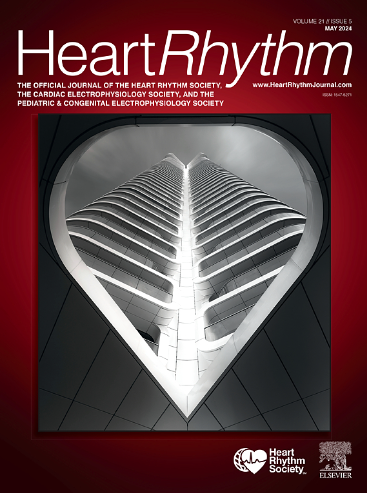Understanding electrical pulmonary vein antrum for paroxysmal atrial fibrillation: Further look into superhigh-density electroanatomic mapping of the left atrium
IF 5.7
2区 医学
Q1 CARDIAC & CARDIOVASCULAR SYSTEMS
引用次数: 0
Abstract
Background
An isolation line placed at the pulmonary vein antrum (PVA) area is superior to ostium level in atrial fibrillation (AF) control. However, less is known about the electrophysiologic characteristics of the PVA.
Objective
The aim of this study was to describe the electrophysiologic properties of the PVA.
Methods
High-density mapping of the left atrium was performed in 18 paroxysmal AF (PAF) patients and 9 age- and sex-matched paroxysmal supraventricular tachycardia (PSVT) patients. Each PVA was divided into 8 segments, and the pulmonary vein (PV) was divided into 4 segments. The electrophysiologic properties included slow conduction, complex fractionated electrograms, and effective refractory period (ERP).
Results
Slow conduction was more prevalent at the PVA (43.2% ± 19.5% vs 14.7% ± 13.0%; P = .001) and PV (61.9% ± 16.4% vs 9.1% ± 9.0%; P < .001) in PAF patients than in PSVT patients during sinus rhythm. Similarly, the area with complex fractionated electrograms was significantly larger at the PVA (133.8 [61.6–233.2] mm2 vs 0.0 [0.0–41.4] mm2; P = .011) in PAF patients during sinus rhythm. The ERP of the PVA was longer in PAF patients than in control at the drive length of 600 ms (260 [230–280] ms vs 220 [190–250] ms; P = .001) and 400 ms (230 [205–250] ms vs 200 [190–220] ms; P = .007). The ERP net difference between the PV and PVA is larger in PAF patients than in control both at 600-ms pacing (40 [20–70] ms vs 10 [10–30] ms; P < .001) and at 400-ms pacing (40 [20–60] ms vs 20 [10–30] ms; P < .001).
Conclusion
PAF patients have the PVA electrical substrate including slow conduction, complex fractionated electrograms, and ERP dispersion.

了解阵发性心房颤动的肺静脉电窦道:进一步了解左心房超高密度电解剖图。
背景:在心房颤动(房颤)控制中,置于肺静脉窦(PVA)区域的隔离线优于窦口水平。然而,人们对 PVA 的电生理特性知之甚少:方法:对 18 名阵发性房颤(PAF)患者和 9 名年龄和性别匹配的阵发性室上性心动过速(PSVT)患者的左心房进行高密度绘图。每条 PVA 被分为 8 段,肺静脉 (PV) 被分为 4 段。电生理特性包括缓慢传导、复杂的分段电图和有效折返期(ERP):结果:在SR期间,PAF患者的慢传导在PVA(43.2±19.5 vs. 14.7±13.0%,P=0.001)和PV(61.9±16.4 vs. 9.1±9.0%,P2,P=0.011)更为普遍。在驱动长度为 600 ms(260 [230, 280] vs. 220 [190, 250] ms,P=0.001)和 400 ms(230 [205, 250] vs. 200 [190, 220] ms,P=0.007)时,PAF 患者 PVA 的 ERP 比对照组长。PAF 患者 PV 和 PVA 之间的 ERP 净差在 600 ms 时均大于对照组(40 [20, 70] vs. 10 [10, 30] ms,P=0.007):PAF 患者具有 PVA 电基质,包括缓慢传导、复杂的分馏电图和 ERP 弥散。
本文章由计算机程序翻译,如有差异,请以英文原文为准。
求助全文
约1分钟内获得全文
求助全文
来源期刊

Heart rhythm
医学-心血管系统
CiteScore
10.50
自引率
5.50%
发文量
1465
审稿时长
24 days
期刊介绍:
HeartRhythm, the official Journal of the Heart Rhythm Society and the Cardiac Electrophysiology Society, is a unique journal for fundamental discovery and clinical applicability.
HeartRhythm integrates the entire cardiac electrophysiology (EP) community from basic and clinical academic researchers, private practitioners, engineers, allied professionals, industry, and trainees, all of whom are vital and interdependent members of our EP community.
The Heart Rhythm Society is the international leader in science, education, and advocacy for cardiac arrhythmia professionals and patients, and the primary information resource on heart rhythm disorders. Its mission is to improve the care of patients by promoting research, education, and optimal health care policies and standards.
 求助内容:
求助内容: 应助结果提醒方式:
应助结果提醒方式:


